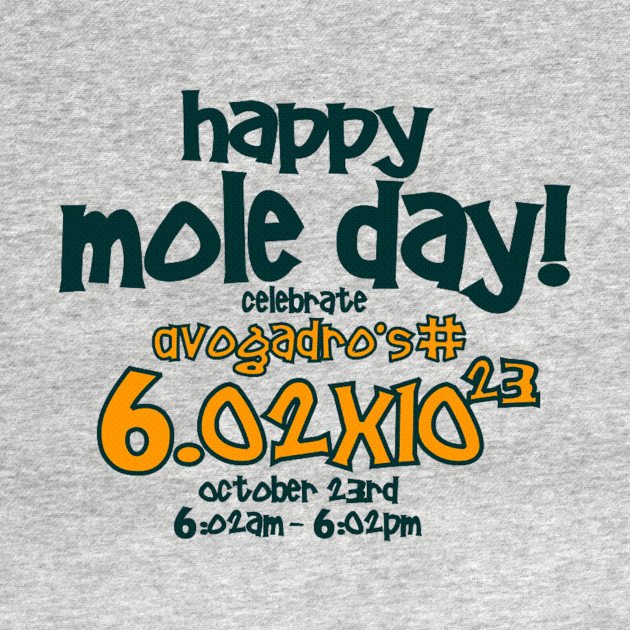- Avogadro's Number Symbol
- Avogadro's Number Mole Day
- Formula Avogadro's Number
- Avogadro's Number Day
- Avogadro's Number Conversion
The time and date are derived from the Avogadro number, which is approximately 6.02 × 1023, defining the number of particles (atoms or molecules) in one mole (mol) of substance, one of the seven base SI units. Text books in 1958 gave Avogadro's number as 6.02 times 10 to the 23rd. The current value is 6.022137 times 10 to the 23rd. The answer to the above question was supplied by Reed Howard, Department of Chemistry and Biochemistry, Montana State University. It is difficult to imagine such a large number as Avogadro's number. Today Avogadro’s number(6.022140857 × 10^ 23) has such a great importance that mole day is being celebrated every year by the chemists unofficially on 23 rd October beginning from 6:02 AM to 6: 02 PM to make sense to Avogadro’s number. We know that the nucleus of an atom makes up more than 99.9% of its mass.

Avogadro Number Analogies
Avogado's Number is so large many students have trouble comprehending its size. Consequently, a small sidelight of chemistry instruction has developed for writing analogies to help express how large this number actually is.
Before looking over the following examples, here's a nice YouTube video about the mole and Avogadro's Number. Have fun and please come back to the ChemTeam when you're done exploring.
1) Avogadro's Number compared to the Population of the Earth:
We will take the population of the earth to be six billion (6 x 109 people). We compare to Avogadro's Number like this:
Avogadro's Number Symbol
6.022 x 1023 divided by 6 x 109 = approx. 1 x 1014
In other words, it would take about 100 trillion Earth populations to sum up to Avogadro's number.
If we were to take a value of 7 billion (approximate population in 2012), it would take about 86 trillion Earth populations to sum up to Avogadro's Number.
2) Avogadro's Number as a Balancing Act:
Avogadro's Number Mole Day
At the very moment of the Big Bang, you began putting H atoms on a balance and now, 19 billion years later, the balance has reached 1.008 grams. Since you know this to be Avogadro Number of atoms, you stop and decide to calculate how many atoms per second you had to have placed.
1.9 x 1010 yrs x 365.25 days/yr x 24 hrs/day x 3600 sec/hr = 6.0 x 1017 seconds to reach one mole6.022 x 1023 atoms/mole divided by 6.0 x 1017 seconds/mole = approx. 1 x 106 atoms/second
So, after placing one million H atoms on a balance every second for 19 billion years, you get Avogadro Number of H atoms (approximately).
3) Avogadro's Number in Outer Space:

If all the matter in the universe were spread evenly throughout the entire universe, there would be approx. 1 x 10¯6 nucleons per cm3. We could do several things with that. For example:
a) What volume (in cm3) of space would hold Avogadro Number of nucleons?6.022 x 1023 nucleons/mole divided by 1 x 10¯6 nucleons/cm3 = 6.022 x 1029 cm3/moleb) How many Earths would equal this volume of space (take Earth's radius to be 6380 km)?
4) Avogadro Number of Coins:
Take a common coin of your country and stack up 30 of them. Measure the height in cm and divide by 30. You now have the average height of one coin in centimeters.
a) How high in cm is a stack of Avogadro Number of that coin?
b) How many light years is this? (Light travels 3.00 x 108 km per second)
c) How many 'round-trips' is this to the moon? (Go there and back = one round-trip. The Earth-Moon distance (measured center-to-center is a bit more than 384,000 km.)
Another way to express this type of problem: If you placed one mole of pills (coins, etc.) with a diameter of 1.00 cm side by side, how many trips around the Sun's equator can you make?
Solution:
1) Convert diameter of Sun from km to cm:
(1.392 x 106 km x (105Formula Avogadro's Number
cm / 1 km) = 1.392 x 1011 cm
I looked up the diameter of the Sun online.
2) Calculate circumference of sun:c = πdc = (3.14159) (1.392 x 1011 cm)
c = 4.3731 x 1011 cm
3) Calculate trips around the Sun:
Since each pill = 1.00 cm, one mole of them covers 6.022 x 1023 cm6.022 x 1023 cm / 4.3731 x 1011 cm
1.377 x 1012 times around the Sun.
5) Avogadro Number of Pieces of Paper:
Avogadro's Number Day
If you had a mole of sheets of paper stacked on top of each other, how many round trips to the Moon could you make? (Hint: a stack of 100 sheets of ordinary printer paper is about 1.0 cm.)
6) The area of the ChemTeam's home state of California is 403932.8 km2. Suppose you had 6.022 x 1023 sheets of paper, each with dimensions 30 cm x 30 cm. (a) How many times could you cover California completely with paper? (b) Suppose each sheet of paper is 1 mm thick. How high would the paper be stacked?
7) If you drove 6.022 x1023 days at a speed of 100 km/h, how far would you travel?
Avogadro's Number Conversion
8) If you spent 6.022 x 1023 dollars at an average rate of 1.00 dollar/s, how long in years would the money last? (Assume that every year has 365 days.)

